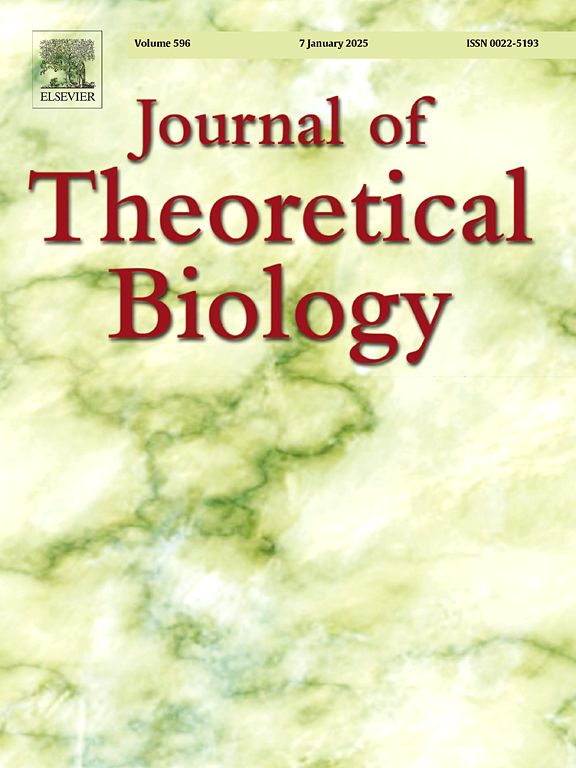Exploration of Hepatitis B Virus Infection Dynamics through an Intracellular Model
IF 1.9
4区 数学
Q2 BIOLOGY
引用次数: 0
Abstract
Analysis of the cell population generally provides average information about viral infection in a host whereas the intracellular model captures the individual cellular responses. The primary goal of this study is to comprehensively analyze the intracellular dynamics of hepatitis B virus (HBV) infection and to identify the most influential factors. In this study, an intracellular HBV infection dynamics model is proposed by considering several intracellular steps that are observed in the virus life cycle. Upon comparison with the experimental data, it is seen that the model solutions exhibit a good agreement. The well-known fourth-order Runge-Kutta method is applied to numerically solve the proposed model. The effects of HBx proteins, dslDNA-containing intermediates, intracellular delay and initial concentration of cccDNAs are explicitly studied. In order to identify the most positively and also the most negatively sensitive parameter of the proposed model, the global sensitivity analysis is performed using the widely-used method, Latin hypercube sampling-partial rank correlation coefficients. As a result, it is observed that HBx proteins have notable impacts on the dynamics of the infection, whereas intracellular delay and dslDNA-containing intermediates may not significantly affect the infection. This study also suggests that sub-viral particles could potentially contribute to the progression of the infection. Furthermore, recycling of capsids (an intracellular process perhaps unique to the HBV life cycle, where a portion of the newly produced capsids return to the nucleus and amplify the cccDNAs) is found to play an important role in enhancing the infection.
通过细胞内模型探索乙型肝炎病毒感染动力学。
对细胞群的分析通常提供宿主病毒感染的平均信息,而细胞内模型捕获单个细胞的反应。本研究的主要目的是全面分析乙型肝炎病毒(HBV)感染的细胞内动力学,并确定最重要的影响因素。在这项研究中,通过考虑在病毒生命周期中观察到的几个细胞内步骤,提出了细胞内HBV感染动力学模型。通过与实验数据的比较,可以看出模型解具有较好的一致性。采用四阶龙格-库塔法对模型进行了数值求解。明确研究了HBx蛋白、含dsldna的中间体、细胞内延迟和cccdna初始浓度的影响。为了识别模型中最积极和最消极的敏感参数,采用广泛使用的拉丁超立方体抽样-偏秩相关系数方法进行全局敏感性分析。因此,我们观察到HBx蛋白对感染动力学有显著影响,而细胞内延迟和含dsldna的中间体可能对感染没有显著影响。这项研究还表明,亚病毒颗粒可能有助于感染的进展。此外,衣壳的再循环(可能是HBV生命周期中独特的细胞内过程,其中一部分新产生的衣壳返回细胞核并扩增cccdna)被发现在增强感染中起重要作用。
本文章由计算机程序翻译,如有差异,请以英文原文为准。
求助全文
约1分钟内获得全文
求助全文
来源期刊
CiteScore
4.20
自引率
5.00%
发文量
218
审稿时长
51 days
期刊介绍:
The Journal of Theoretical Biology is the leading forum for theoretical perspectives that give insight into biological processes. It covers a very wide range of topics and is of interest to biologists in many areas of research, including:
• Brain and Neuroscience
• Cancer Growth and Treatment
• Cell Biology
• Developmental Biology
• Ecology
• Evolution
• Immunology,
• Infectious and non-infectious Diseases,
• Mathematical, Computational, Biophysical and Statistical Modeling
• Microbiology, Molecular Biology, and Biochemistry
• Networks and Complex Systems
• Physiology
• Pharmacodynamics
• Animal Behavior and Game Theory
Acceptable papers are those that bear significant importance on the biology per se being presented, and not on the mathematical analysis. Papers that include some data or experimental material bearing on theory will be considered, including those that contain comparative study, statistical data analysis, mathematical proof, computer simulations, experiments, field observations, or even philosophical arguments, which are all methods to support or reject theoretical ideas. However, there should be a concerted effort to make papers intelligible to biologists in the chosen field.

 求助内容:
求助内容: 应助结果提醒方式:
应助结果提醒方式:


